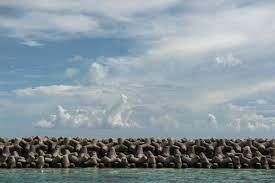The Maldives is the vacation destination preferred by the world’s most common and wealthy man. The Maldives are a group of coral atolls formed by the sunken summits of an old volcanic mountain range.
None of the islands rise more than six feet (1.8 meters) above sea level; they are all low-lying. The islands are shielded from the damaging impacts of monsoons by barrier reefs. The northeast monsoon offers dry and mild breezes from December to March, whereas the southwest monsoon brings the rainy season, which runs from May to August.
The autonomous island nation of Maldives is located in the north-central Indian Ocean. It is made up of a series of roughly 1,200 tiny atolls, or clusters, of sandbanks and coral islands, 200 of which are inhabited.
Are the Maldives drowning?
The Maldives is a posh vacation spot known for its wide coral reefs, blue lagoons, and white sand beaches. The chain of 1,192 tiny islands has been fighting for its life on the front lines of the climate crisis in recent years.
The former president Mohamed Nasheed forewarned the people, 15 years ago that they would become the first environmental refugees in history to require transfer abroad. He wished for the Maldives to begin setting aside money to purchase land in Australia or one of the neighboring countries, Sri Lanka or India.
However, present President Mohammad Muizzu, 45, stated that his people will not be fleeing their country even though he is requesting over €500 million in external funds to preserve sensitive coasts.

Speaking from the bustling city of Male, which is surrounded by concrete sea walls, Muizzu told news agency AFP, “If we need to increase the area for living or other economic activity, we can do that. We can care for ourselves because we are self-sufficient.”
The environment ministry describes the capital, Male, which has 65,700 people per square kilometer, “one of the most densely populated pieces of land in the world”, where a third of the nation’s 380,000 population are crammed into a tiny island. The city is currently surrounded by a massive sea wall, but Muizzu stated that it may grow beyond. Using sand pushed onto underwater coral platforms, reclamation initiatives have already enlarged the landmass of the nation by around 10% over the previous 40 years, covering 30 square kilometers (11 square miles).

Muizzu, a civil engineer with British training who served as the minister of construction for seven years, was instrumental in that, supervising the growth of the man-made island of Hulhumale.
Over 1.4 kilometers (0.8 miles) of tower blocks soaring high over the turquoise oceans, Hulhumale is connected to the capital by a Chinese-built bridge. With a population of approximately 100,000, it is twice the size of Male. However, rights and environmental organizations caution that although reclamation is necessary, it must be done carefully.
Is evacuating Maldives the only choice?
The Maldives face flooding from rising sea levels, and the Indian Ocean island already lacks safe drinking water. However, the newly elected president claims he has abandoned intentions to relocate citizens. Rather, the nation’s low-lying leader, Mohamed Muizzu, assures that by aggressive land reclamation and the construction of higher islands, the country will defeat the seas. Rights and environmental organizations have cautioned that this would even increase the risk of flooding.
This month, the tiny nation of Tuvalu signed an agreement granting its residents the right to reside in Australia in the event that their Pacific homeland is submerged under the ocean. However, Muizzu declared that the Maldives would not choose that path.
“I can categorically say that we definitely don’t need to buy land or even lease land from any country,” Muizzu stated. According to him, sea barriers will make sure that risk zones can be “classified as a safe island.” However, less than one meter, or three feet, above sea level, lies in 80% of the Maldives.
Furthermore, the future of the beach islands that draw tourists is questionable, despite the fact that densely populated cities ringed by fortress-like walls can keep the waves at bay.
By the end of the century, rises of 18 to 59 centimeters (7.2 to 23.2 inches) would almost certainly render the Maldives uninhabitable, according to a 2007 warning from the UN’s Intergovernmental Panel on Climate Change (IPCC). Already, the caution lights appear to be blinking red.
What does it mean for the economy?
A significant portion of the Maldives’ economy nearly one-third comes from tourism. Because highly populated communities are protected by fortress-like walls, the future of the pristine beach islands, which attract tourists, is yet unknown.

Human Rights Watch (HRW) claimed in a recent report that reclamation projects were “often rushed” and did not have enough mitigation strategies, accusing the government of neglecting to carry out their own environmental standards.
 It cited two examples: a reclamation project at Addu that harmed the coral reefs that fisherman relied on, and an airport on Kulhudhuffushi that left 70% of the island’s mangroves “buried.” According to HRW, “the Maldives government has disregarded or compromised environmental protection laws, increasing the risk of flooding and other harm to island communities.”
It cited two examples: a reclamation project at Addu that harmed the coral reefs that fisherman relied on, and an airport on Kulhudhuffushi that left 70% of the island’s mangroves “buried.” According to HRW, “the Maldives government has disregarded or compromised environmental protection laws, increasing the risk of flooding and other harm to island communities.”
The Maldives, a nation of 185 islands home to over 550,000 people, is an upper-middle-income nation with strong economic growth. The economy has been able to sustain its robust economic pace in 2023 owing to an increase in tourist arrivals; this trend is anticipated to continue as the economy grows and reduces poverty.
However, with this crisis paving its way, the tourism sector is likely to hit a blow.











